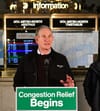Association Veteran Marty Nash Appointed HGAR Interim CEO
Nash has more than 20 years of experience in the Realtor association industry.
A federal judge on Jan. 3 denied New Jersey’s attempt to stop or stall the launch of the congestion tolling plan two days later.

NEW YORK—The Metropolitan Transportation Authority began implementation of the controversial congestion pricing program on Sunday, Jan. 5, as scheduled, after a number of court challenges seeking injunctions were denied.
A federal judge on Jan. 3 denied New Jersey’s attempt to stop or stall the launch of the congestion tolling plan. Proponents of the congestion pricing program pointed to its goals that include infusing $15 billion into the MTA’s capital program as well as reducing traffic congestion and improving air quality in the city’s Central Business District.
After a 90-minute hearing and four hours of closed-door discussions, U.S. District Court Judge Leo Gordon turned aside New Jersey’s argument that implementing congestion pricing would harm New Jersey residents who would possibly suffer from increased traffic from motorists trying to avoid paying the new toll.
The state almost immediately filed an appeal with the U.S. Court of Appeals for the Third Circuit. Judge Gordon rejected New Jersey’s request for a five-day stay so that the state could appeal, according to a story published by the New Jersey Monitor. “We’re going to do this as quickly as we can,” Randy Mastro, the lawyer representing New Jersey, told reporters after Friday’s hearing. “This is so important.”
With the court challenges turned aside, the MTA activated the congestion pricing program, charging a toll for motorists to enter Manhattan below 60th Street, formally known as the Central Business District (CBD)—now also referred to as the Congestion Relief Zone—to reduce traffic congestion and raise needed revenue to improve public transportation. The program launched Sunday morning, Jan. 5, at 12:00:01 a.m. charges for automobile drivers using E-ZPass, a peak toll for vehicles entering the CRZ at $9.00 and an overnight rate of $2.25.
MTA officials held a press briefing on Sunday heralding the launch of the nation’s first congestion pricing program.
“The Congestion Relief Zone has been in operation since midnight – 1,400 cameras, over 110 detection points, over 800 signs and 400 lanes of traffic and it’s all gone smoothly,” said MTA Chair and CEO Janno Lieber. “We want to encourage trucks to do more deliveries at night, we want improvements to vehicle speeds especially for buses, we want to make sure that emergency response vehicles can get where they are going faster, and I hope drivers will take another look at the speed and convenience of mass transit.”
"Thanks to congestion pricing, MTA Construction & Development will undertake a generational investment to transform public transit in New York," said MTA Construction & Development President Jamie Torres-Springer. "We're ready to get these projects started and we're ready to deliver them better, faster, and cheaper than ever before."
Opponents of congestion pricing blasted the MTA and others over the congestion pricing program that they feel unfairly targets Hudson Valley residents.
Rockland County Executive Ed Day after the county’s attempt to impose an injunction on congestion pricing was denied in late December, said: “The MTA’s congestion pricing plan unfairly burdens Rockland County drivers, who already pay their fair share to maintain and use New York’s transportation infrastructure, without receiving equitable access to public transit. It imposes additional costs on hard-working residents who have limited alternatives and disproportionately impacts families, small businesses, and those who rely on vehicles to earn a living.”
He later added Rockland County deserves better, and we will not back down in our pursuit of fairness and equity for our community. Our fight is not over, and we stand united in opposition to any plan that treats our residents as second-class citizens.”
U.S. Rep. Mike Lawler (R-NY-17) said, “Congestion pricing is a corrupt cash grab, and the fact that Governor Hochul is literally celebrating it shows what little regard she has for hard-working New Yorkers already struggling to make ends meet.”
Eighty percent of the revenue generated will go to capital improvements on NYC Subways and Buses, 10% to Metro-North Railroad and 10% percent to the Long Island Rail Road.
A phased-in toll plan that starts at 40% of the eventual toll enables the MTA to issue $15 billion in bonds to fund the MTA’s 2020-2024 Capital Plan and advance critical capital projects. After the pause on congestion pricing was lifted, the MTA exercised the option to purchase 265 zero-emission buses on Nov. 27.
The program provides $335 million in mitigation programs, including $148 million in regional mitigation measures and monitoring of traffic, air quality, and transit station elements, and $82 million for the Low-Income Discount Plan. In addition, the program also committed $100 million in funding for place-based mitigation to 13 environmental justice communities in the Bronx, Brooklyn, Upper Manhattan and New Jersey: The Bronx: Crotona-Tremont, High Bridge-Morrisania, Hunts Point, Mott Haven, Northeast Bronx, Pelham-Throgs Neck; Brooklyn: Downtown Brooklyn-Fort Greene, South Williamsburg; Upper Manhattan: East Harlem, Randall’s Island; New Jersey: Newark, Orange, East Orange and Fort Lee.
Receive original business news about real estate and the REALTORS® who serve the lower Hudson Valley, delivered straight to your inbox. No credit card required.